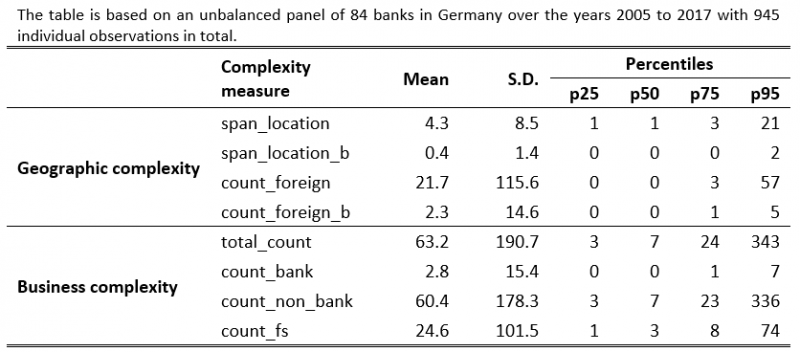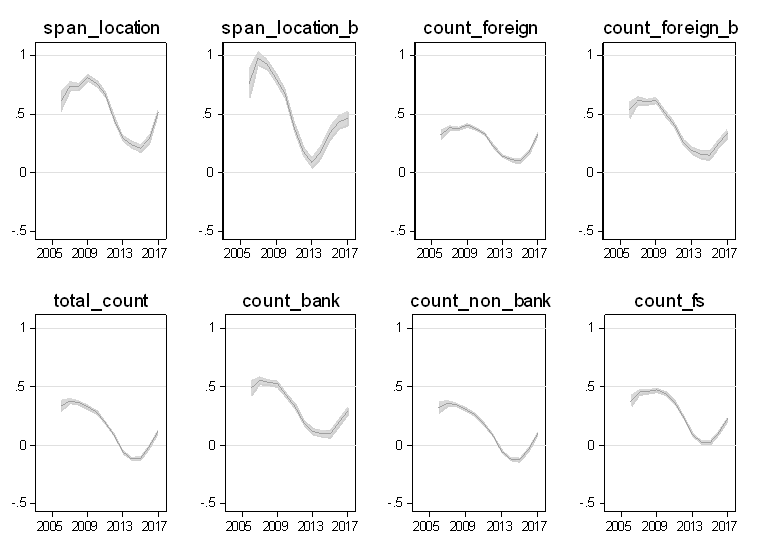References
BCBS [Basel Committee on Banking Supervision] (2010). Basel III: A global regulatory framework for more resilient banks and banking systems. December 2010.
Berger, A., S. El Ghoul, O. Guedhami, and R. Roman (2017). Internationalization and Bank Risk. Management Science 63(7): 2283-2301.
Boot, A.W.A. and A. Schmeits (2000). Market discipline and incentive problems in conglomerate firms with applications to banking. Journal of Financial Intermediation 9(3): 240-273.
Carmassi, J., and R. Herring (2016). The Corporate Complexity of Global Systemically Important Banks. Journal of Financial Services Research 49: 175-201.
Cetorelli N., M.G. Jacobides, and S. Stern (2017). Transformation of Corporate Scope in U.S. Banks: Patterns and Performance Implications. Federal Reserve Bank of New York Staff Report 813.
Cetorelli, N., and L. Goldberg (2014). Measures of Global Bank Complexity. FRBNY Economic Policy Review 20(2), 107-126.
Cetorelli, N., and L. Goldberg (2016). Organizational Complexity and Balance Sheet Management in Global Banks. Federal Reserve Bank of New York Staff Reports772, April 2016.
CGFS [Committee on the Global Financial System] (2018). Structural changes in banking after the crisis. CGFS Papers No 60.
Dam, L., and M. Kötter (2012). Bank Bailouts and Moral Hazard: Evidence from Germany, Review of Financial Studies 25: 2343‐2380.
Dewatripont, M., and J. Mitchell (2005). Risk-taking in financial conglomerates. Unpublished manuscript. ECARES, Université Libre de Bruxelles.
Goetz, M. R., L. Laeven, and R. Levine (2016). Does the geographic expansion of banks reduce risk? Journal of Financial Economics 120: 346-362.
Goldberg, L., and A. Meehl (2020). Complexity in large US Banks. FRBNY Economic Policy Review 26(2): 1-28.
Houston, J. F., C. Lin, and Y. Ma (2012). Regulatory arbitrage and international bank flows. Journal of Finance 67(5): 1845-1895.
Laeven, L. and R. Levine (2007). Is there a diversification discount in financial conglomerates? Journal of Financial Economics 85: 331–367.
Laeven, L. and R. Levine (2009). Bank governance, regulation and risk-taking. Journal of Financial Economics 93: 259-275.
Lepetit, L. and F. Strobel (2015). Bank insolvency risk and Z-score measures: A refinement. Finance Research Letters 13: 214-224.
Martynova, N. and U. Vogel (2021). Banks’ complexity-risk nexus and the role of regulation. Journal of Banking & Finance, forthcoming.
Scharfstein, D.S., and J.C. Stein (2000) The dark side of internal capital markets: Divisional rent-seeking and inefficient investment. Journal of Finance 55 (6): 2537-2564.
Wagner, W. (2010). Diversification at Financial Institutions and Systemic Crises. Journal of Financial Intermediation 19: 373-386.






